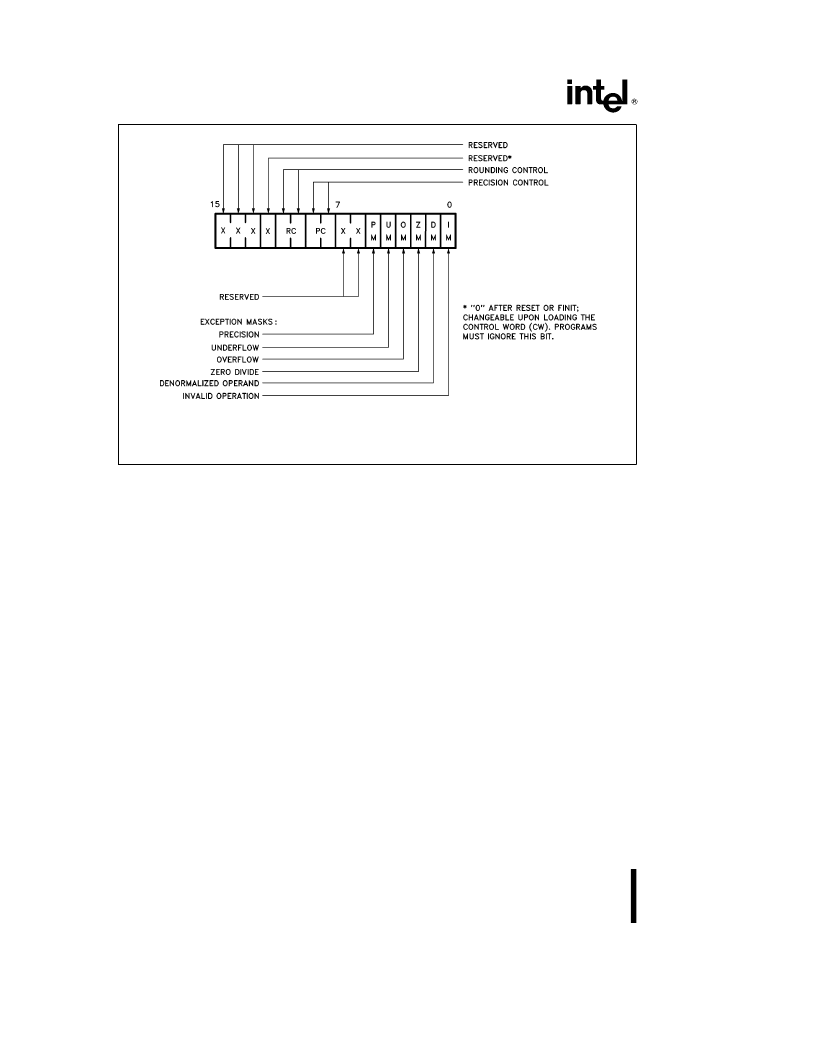- 您現(xiàn)在的位置:買(mǎi)賣(mài)IC網(wǎng) > PDF目錄360867 > INTEL387DX Intel387 DX - MATH COPROCESSOR PDF資料下載
參數(shù)資料
| 型號(hào): | INTEL387DX |
| 英文描述: | Intel387 DX - MATH COPROCESSOR |
| 中文描述: | Intel387霉素-數(shù)學(xué)協(xié)處理器 |
| 文件頁(yè)數(shù): | 14/41頁(yè) |
| 文件大小: | 435K |
| 代理商: | INTEL387DX |
第1頁(yè)第2頁(yè)第3頁(yè)第4頁(yè)第5頁(yè)第6頁(yè)第7頁(yè)第8頁(yè)第9頁(yè)第10頁(yè)第11頁(yè)第12頁(yè)第13頁(yè)當(dāng)前第14頁(yè)第15頁(yè)第16頁(yè)第17頁(yè)第18頁(yè)第19頁(yè)第20頁(yè)第21頁(yè)第22頁(yè)第23頁(yè)第24頁(yè)第25頁(yè)第26頁(yè)第27頁(yè)第28頁(yè)第29頁(yè)第30頁(yè)第31頁(yè)第32頁(yè)第33頁(yè)第34頁(yè)第35頁(yè)第36頁(yè)第37頁(yè)第38頁(yè)第39頁(yè)第40頁(yè)第41頁(yè)

Intel387
TM
DX MATH COPROCESSOR
240448–4
Precision Control
00D24 bits (single precision)
01D(reserved)
10D53 bits (double precision)
11D64 bits (extended precision)
Rounding Control
00DRound to nearest or even
01DRound down (toward
b
%
)
10DRound up (toward
a
%
)
11DChop (truncate toward zero)
Figure 2.7. Intel387
TM
DX MCP Control Word
2.3.5 CONTROL WORD
The MCP provides several processing options that
are selected by loading a control word from memory
into the control register. Figure 2.7 shows the format
and encoding of fields in the control word.
The low-order byte of this control word configures
the MCP error and exception masking. Bits 5–0 of
the control word contain individual masks for each of
the six exceptions that the MCP recognizes.
The high-order byte of the control word configures
the MCP operating mode, including precision and
rounding.
#
Bit 12 no longer defines infinity control and is a
reserved bit. Only affine closure is supported for
infinity arithmetic. The bit is initialized to zero after
RESET or FINIT and is changeable upon loading
the CW. Programs must ignore this bit.
#
The rounding control (RC) bits (bits 11–10) pro-
vide for directed rounding and true chop, as well
as the unbiased round to nearest even mode
specified in the IEEE standard. Rounding control
affects only those instructions that perform
rounding at the end of the operation (and thus
can generate a precision exception); namely,
FST, FSTP, FIST, all arithmetic instructions (ex-
cept FPREM, FPREM1, FXTRACT, FABS, and
FCHS), and all transcendental instructions.
#
The precision control (PC) bits (bits 9–8) can be
used to set the MCP internal operating precision
of the significand at less than the default of 64
bits (extended precision). This can be useful in
providing compatibility with early generation arith-
metic processors of smaller precision. PC affects
only the instructions ADD, SUB, DIV, MUL, and
SQRT. For all other instructions, either the preci-
sion is determined by the opcode or extended
precision is used.
2.4 Interrupt Description
Several interrupts of the Intel386 DX CPU are used
to report exceptional conditions while executing nu-
meric programs in either real or protected mode. Ta-
ble 2.6 shows these interrupts and their causes.
14
14
相關(guān)PDF資料 |
PDF描述 |
|---|---|
| INTEL740 | 64-Bit Graphics (GUI) Accelerator |
| INTRO_TO_TRANSISTOR | |
| INTRUMENT | For EM60000 series |
| IO100VXI | |
| IO110VXI | |
相關(guān)代理商/技術(shù)參數(shù) |
參數(shù)描述 |
|---|---|
| INTEL387SX | 制造商:INTEL 制造商全稱:Intel Corporation 功能描述:Intel387 SX - MATH COPROCESSOR |
| INTEL387TMDX | 制造商:INTEL 制造商全稱:Intel Corporation 功能描述:Intel387TM DX MATH COPROCESSOR |
| INTEL740 | 制造商:未知廠家 制造商全稱:未知廠家 功能描述:64-Bit Graphics (GUI) Accelerator |
| INTEL82801 | 制造商:INTEL 制造商全稱:Intel Corporation 功能描述:82801AB (ICH0) I/O Controller Hub |
| INTEL82802AB | 制造商:INTEL 制造商全稱:Intel Corporation 功能描述:Firmware Hub (FWH) |
發(fā)布緊急采購(gòu),3分鐘左右您將得到回復(fù)。